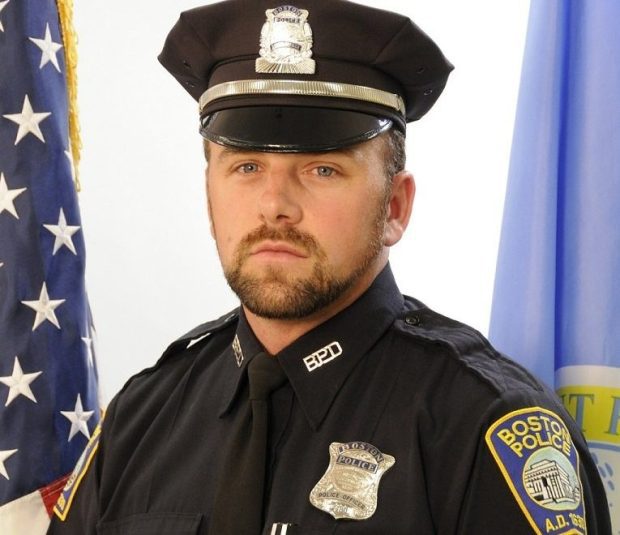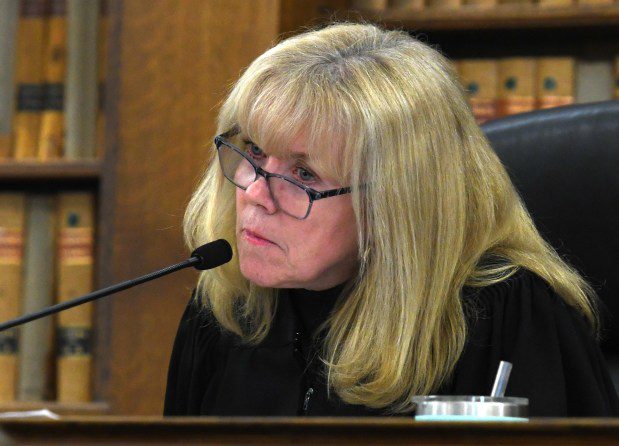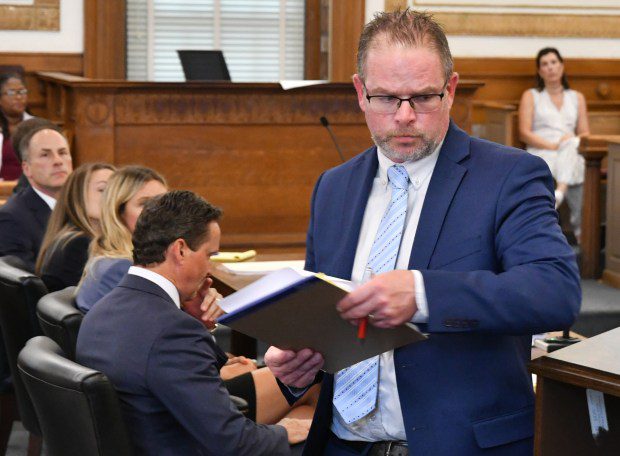The trial for the murder of Karen Read is scheduled to take place this week in Norfolk Superior Court in Dedham, and the case is quite complicated.
On Saturday afternoon, a Google search for the defendant's name in quotes yielded over nine million results. A quick look at online discussions on platforms like Reddit or X (formerly known as Twitter) can lead one into a deep rabbit hole that could consume hours, days, or even months.
Many people are incredibly interested in the specific details of the case and have strong opinions about the guilt or innocence of the 44-year-old former financial analyst and Bentley University lecturer from Mansfield. She is accused of killing her boyfriend, Boston Police Officer John O'Keefe, in Canton on January 29, 2022.
Regardless of one's interest in true crime, this case involves a wide range of allegations including conspiracy, dog attacks, corruption within the police and prosecution, witness intimidation, extramarital affairs, intoxication, a network of influential men, tampering with evidence, surveillance cameras, suspicious Google searches, phone tracking, and even a mysterious federal investigation looming over it all.
According to Judge Beverly Cannone, the amount of evidence discovery filed in the case is estimated to be 4,500 pages.
In other words, it's difficult to see the bigger picture when focusing on minor details.
Here is an explanation of the main points of both the defense and prosecution theories regarding what happened in Canton that night.
The charges
Read was charged with second-degree murder, motor vehicle manslaughter, and leaving the scene of a collision causing death on June 9, 2022, which brought her case to the Norfolk Superior Court. She pleaded not guilty to these charges.
The indictment increased the charges from the original ones she was arrested for. She pleaded not guilty in Stoughton District Court on February 2, 2022, to the initial charges of manslaughter, leaving the scene of a motor vehicle collision causing death, and motor vehicle homicide.
The victim

Boston Police Officer John O’Keefe. (BDNews.com photo.)
John O’Keefe, 46, was a member of the BPD for 16 years, and his family described him after his death as not only a dedicated police officer, but also an outstanding guardian, son, brother, uncle, and friend. They considered themselves fortunate to have had him in their lives.
At the time of his death, O’Keefe had been in a relationship with Read for two years.
He also acted as a parental figure and had custody of his niece and nephew, both of whom became orphans when their parents passed away in 2013 and 2014.
A GoFundMe campaign was created to support the children after O'Keefe's death, and it raised a total of $336,735, greatly exceeding its $10,000 goal.
The players
The defense: Boston lawyer David Yannetti has been representing Read since the beginning of the case.
In September 2022, Yannetti was joined by defense attorneys Alan Jackson and Elizabeth Little from the California-based law firm Werksman Jackson & Quinn. Jackson was previously a well-known prosecutor in Los Angeles, noted for his successful prosecution of legendary record producer Phil Spector for murder. He also famously defended Hollywood actor Kevin Spacey from sexual assault charges in Nantucket.

Prosecutor Adam Lally at the Karen Read case final pretrial conference at at Norfolk Superior Court in Dedham. (David L Ryan/Globe Staff)
The prosecution: Norfolk County Assistant District Attorney Adam Lally has been the prosecutor in the case from the beginning. Fellow Norfolk ADA Laura McLaughlin has also joined the prosecution since it came to the Superior Court.
Norfolk DA Michael Morrissey, while not present at the defense table, has been involved in the case. Letters between Morrissey and the U.S. Attorney’s office in Boston — which launched its own investigation in the case — have been submitted as evidence. Morrissey also made an unprecedented public statement on the case, for which the defense has asked him to be sanctioned and his office disqualified. Those motions failed.

Judge Beverly Cannone listens during a Karen Read hearing. (Chris Christo/Boston Herald)
The judge: Norfolk Superior Court Judge Beverly Cannone was appointed to the bench by Gov. Deval Patrick in 2014. A Quincy native, Cannone began her career after graduating from the New England School of law in 1985 as a public defender. She began her judicial career in 2009 with her appointment as judge of the Quincy District Court.
The lead-up to the mystery
O’Keefe and Read, along with others, were at the Waterfall Bar and Grille in downtown Canton at around 11 p.m. on Jan. 28, 2022, and, according to state witness Jennifer McCabe, the pair seemed to be in good moods.
According to summaries in the case file, out of the 1,445 pages that make up the non-public grand jury transcripts, each witness of the night’s outing described “the atmosphere within the bar as friendly with no arguments amongst any of the patrons.”
McCabe told investigators that Read seemed to have brought in a possible vodka-based mixed drink from C.F. McCarthy’s bar across the street, where she and O’Keefe had been drinking before the Waterfall get-together.
When the Waterfall was set to close, the whole party — including Read and O’Keefe — was invited back to 34 Fairview Road, the then-home of Boston Police Det. Sgt. Brian Albert and his wife Nicole Albert. McCabe said she saw O’Keefe and Read leave together.
Canton Police would find O’Keefe’s body in the yard outside that home at around 6 the next morning, as it “was snowing heavily with the wind blowing.” Read, McCabe and a woman named Kerry Roberts signaled an officer as Read tried to warm and resuscitate her boyfriend.
Prosecution’s theory: Read killed O’Keefe
The prosecution and defense theories differ significantly when Read arrives at 34 Fairview Road in her 2021 black Lexus SUV. In short, prosecutors claim that Read struck her car into O’Keefe in front of the property following a drunken argument and that a broken passenger-side rear tail light supports their version of events.
McCabe said that O’Keefe messaged her “where to,” at 12:14 a.m. and called a few minutes later asking for more details. She said Read’s Lexus pulled up near the driveway at around 12:30 a.m. but that her texts to O’Keefe from that point on went unanswered. The SUV then pulled to the other side of the home, where O’Keefe’s body would be found later, and at around 12:45 a.m. left the area.
According to prosecutors, other witnesses from the grand jury supported the claim about where the vehicle was parked, including McCabe’s husband Matthew.
Before 5 a.m., McCabe got a call from O’Keefe’s niece at Read’s request. Read sounded upset on the phone, McCabe told the grand jury, and said she couldn’t remember seeing O’Keefe after the Waterfall and that they had a fight the last time they were together. McCabe said she saw the pair leave together and she had seen Read’s SUV at the property.
McCabe testified to the grand jury that Read drove to her house and she, McCabe, and Kerry Roberts went to look for O’Keefe. Finally, McCabe said Read mentioned having a broken taillight and wondered “Did I hit him?” McCabe said Read spotted O’Keefe before the other two women, who both said the visibility was too bad at that point to see anything.
Roberts received a call from Read around 5 a.m. saying O’Keefe hadn't come home. Roberts said Read was very upset and said O’Keefe was dead and might have been hit by a snow plow. She said Read seemed drunk even at that time and told her, “I was so drunk I don’t even remember going to your sister’s last night.”
A Canton Fire and EMS worker reportedly told investigators that Read said “I hit him, I hit him, I hit him,” a quote that prosecutor Adam Lally used at Read’s lower court arraignment.
The day after, State Police troopers found the Lexus SUV at Read’s parents’ home in Dighton and noticed the rear right passenger side taillight was broken and a large red piece of plastic was missing. Police found pieces that appeared to be from the taillight after searching through the snow at the scene.
According to the prosecutors, witnesses said Read and O’Keefe’s relationship was not good at the time. The couple had argued that morning, and O’Keefe’s niece said they argued “a lot … approximately two to three times a week … and it was mostly yelling.”
There was also jealousy, as prosecutors say the children stated that Read accused O’Keefe of kissing someone else during a New Year’s trip to Aruba. About a week before the fateful night, the niece said, O’Keefe told Read their relationship had run its course.
An analysis of logs from O’Keefe’s cell phone, which was found under his body, showed significant relationship problems and that Read left him voicemails around the time of his death with the words, “John, I (expletive) hate you.”
The defense's claim is that it's a cover-up
The defense argues that O’Keefe’s severe injuries couldn't have been caused by being hit by a car as the prosecution suggests. They claim that Read was dealing with health issues and dropped O’Keefe off for the after party, and that he was beaten inside the home and then placed on the lawn to frame Read.
Lawyers have argued for a “third-party culpability” defense, claiming someone else killed the victim, since last year.
Judge Cannone decided that the defense can't make this argument in their opening statement, but can “develop” it during the trial.
Attorney David Yannetti stated in the final hearing before jury selection that both his team’s expert witness and experts involved in the federal investigation have supported the view that O’Keefe’s injuries do not match those from being hit by a car.
Yannetti said, “If Mr. O’Keefe wasn't hit by a car, then the defendant did not kill him.” He also mentioned that they have the right to raise a third-party culpability defense.
He identified three specific individuals whom he claims had the motive and opportunity to kill O’Keefe.
Those individuals are Brian Albert, the previous owner of the home; Colin Albert, Brian Albert’s then-16-year-old nephew; and Brian Higgins, a federal special agent with the Bureau of Alcohol, Tobacco, Firearms and Explosives (ATF) who has an office at the Canton Police Department.
Yannetti suggested that Higgins had a previous romantic relationship with Read and implied jealousy as a motive for killing O’Keefe. He also mentioned that Colin Albert had a history of conflict with O’Keefe. Yannetti claimed Brian Albert had shown hostility toward O’Keefe, and when a fellow police officer was fatally wounded on his property, he failed to assist, which Yannetti believes shows “consciousness of guilt.”
Yannetti clarified, “It's not our job to solve this case for the prosecution,” but only to defend the client. He argued that there's enough evidence to suggest someone else killed O’Keefe, but finding the real culprit has been hindered by an extensive conspiracy and cover-up.
He noted a history between the main MSP investigator, Trooper Michael Proctor, and the Albert family. The defense has also argued the same for Canton Police Sgt. Michael Lank, who was the first to arrive at the scene.

Norfolk Assistant District Attorney Adam Lally approaches the podium to speak in court during a hearing for Karen Read in Norfolk Superior Court. (Chris Christo/Boston Herald)









